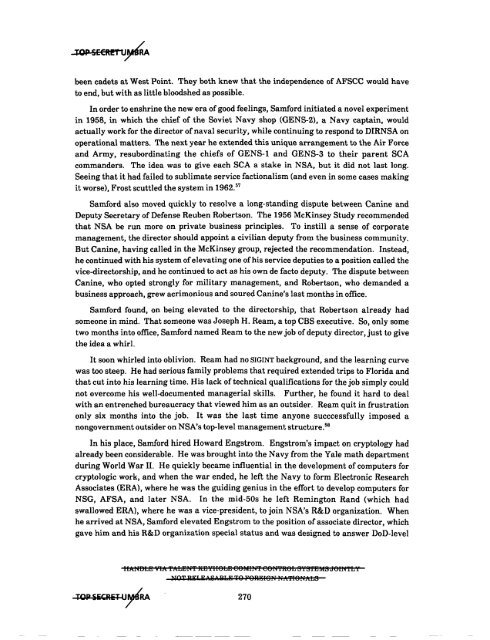American Cryptology during the Cold War - The Black Vault
American Cryptology during the Cold War - The Black Vault
American Cryptology during the Cold War - The Black Vault
Create successful ePaper yourself
Turn your PDF publications into a flip-book with our unique Google optimized e-Paper software.
lOP SECR!T"U~<br />
been cadets at West Point. <strong>The</strong>y both knew that <strong>the</strong> independence of AFSCC would have<br />
to end, but with as little bloodshed as possible.<br />
In order to enshrine <strong>the</strong> new era of good feelings, Samford initiated a novel experiment<br />
in 1958, in which <strong>the</strong> chief of <strong>the</strong> Soviet Navy shop (GENS-2), a Navy captain, would<br />
actually work for <strong>the</strong> director ofnaval security, while continuing to respond to DIRNSA on<br />
operational matters. <strong>The</strong> next year he extended this unique arrangement to <strong>the</strong> Air Force<br />
and Army, resubordinating <strong>the</strong> chiefs of GENS-1 and GENS-3 to <strong>the</strong>ir parent SCA<br />
commanders. <strong>The</strong> idea was to give each SCA a stake in NSA, but it did not last long.<br />
Seeing that it had failed to sublimate service factionalism (and even in some cases making<br />
it worse), Frost scuttled <strong>the</strong> system in 1962. 57<br />
Samford also moved quickly to resolve a long-standing dispute between Canine and<br />
Deputy Secretary of Defense Reuben Robertson. <strong>The</strong> 1956 McKinsey Study recommended<br />
that NSA be run more on private business principles. To instill a sense of corporate<br />
management, <strong>the</strong> director should appoint a civilian deputy from <strong>the</strong> business community.<br />
But Canine, having called in <strong>the</strong> McKinsey group, rejected <strong>the</strong> recommendation. Instead,<br />
he continued with his system ofelevating one ofhis service deputies to a position called <strong>the</strong><br />
vice-directorship, and he continued to act as his own de facto deputy. <strong>The</strong> dispute between<br />
Canine, who opted strongly for military management, and Robertson, who demanded a<br />
business approach, grew acrimonious and soured Canine's last months in office.<br />
Samford found, on being elevated to <strong>the</strong> directorship, that Robertson already had<br />
someone in mind. That someone was Joseph H. Ream, a top CBS executive. So, only some<br />
two months into office, Samford named Ream to <strong>the</strong> new job of deputy director, just to give<br />
<strong>the</strong> idea a whirl.<br />
It soon whirled into oblivion. Ream had no SIGINT background, and <strong>the</strong> learning curve<br />
was too steep. He had serious family problems that required extended trips to Florida and<br />
that cut into his learning time. His lack of technical qualifications for <strong>the</strong> job simply could<br />
not overcome his well-documented managerial skills. Fur<strong>the</strong>r, he found it hard to deal<br />
with an entrenched bureaucracy that viewed him as an outsider. Ream quit in frustration<br />
only six months into <strong>the</strong> job. It was <strong>the</strong> last time anyone succcessfully imposed a<br />
nongovernmentoutsider on NSA's top-level management structure. 58<br />
In his place, Samford hired Howard Engstrom. Engstrom's impact on cryptology had<br />
already been considerable. He was brought into <strong>the</strong> Navy from <strong>the</strong> Yale math department<br />
<strong>during</strong> World <strong>War</strong> II. He quickly became influential in <strong>the</strong> development of computers for<br />
cryptologic work, and when <strong>the</strong> war ended, he left <strong>the</strong> Navy to form Electronic Research<br />
Associates (ERA), where he was <strong>the</strong> guiding genius in <strong>the</strong> effort to develop computers for<br />
NSG, AFSA, and later NSA. In <strong>the</strong> mid-50s he left Remington Rand (which had<br />
swallowed ERA), where he was a vice-president, to join NSA's R&D organization. When<br />
he arrived at NSA, Samford elevated Engstrom to <strong>the</strong> position ofassociate director, which<br />
gave him and his R&D organization special status and was designed to answer DoD-level<br />
Ib\ItBf:::l!J VIA 'fAf:::l!JIt'f U'l!JYIISf:::l!J eSflIIN'f eSff'fftSf::: S'1'S'fl!JMSJ6II{Yf::: 1<br />
~o:r Ri" Ii: A i A libil TQ FQRilI8!'f !'f/t'fISfhltf:::S<br />
270
















